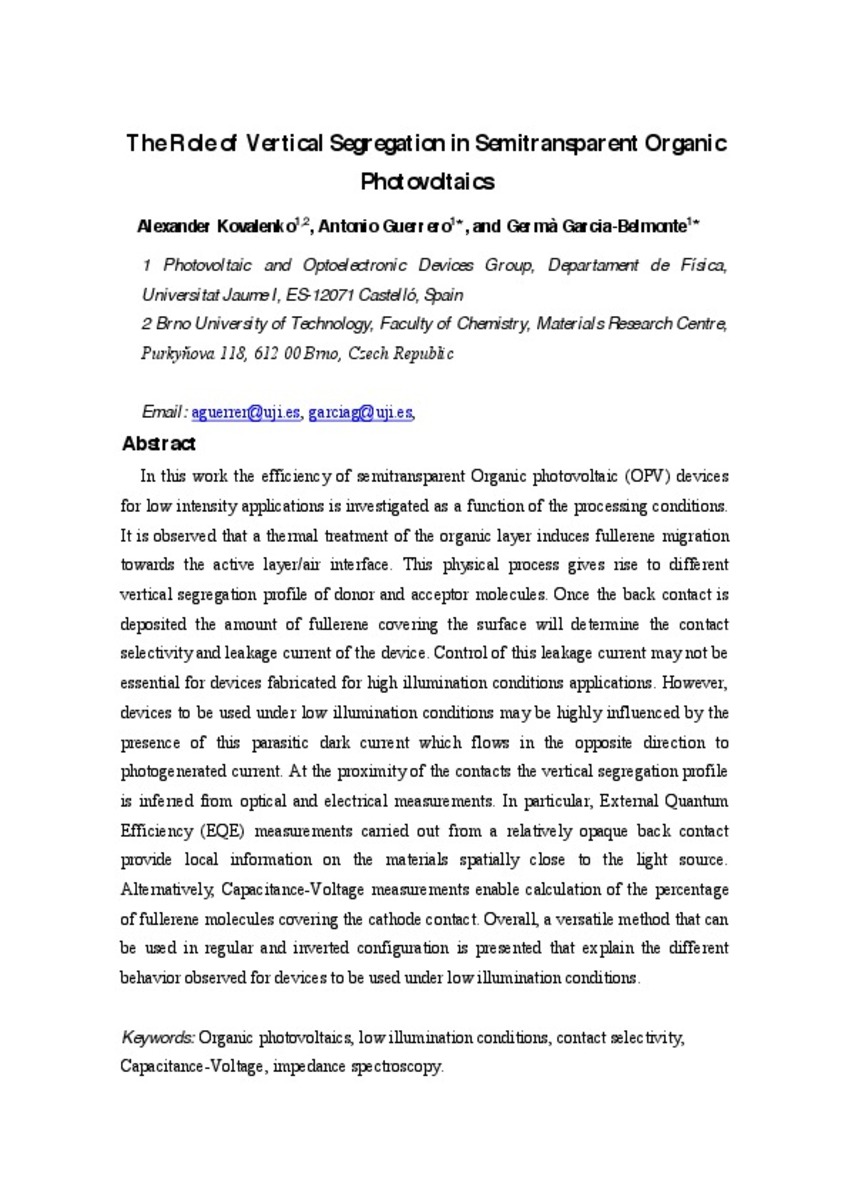Mostrar el registro sencillo del ítem
Role of Vertical Segregation in Semitransparent Organic Photovoltaics
| dc.contributor.author | Kovalenko, Alexander | |
| dc.contributor.author | Guerrero, Antonio | |
| dc.contributor.author | Garcia-Belmonte, Germà | |
| dc.date.accessioned | 2016-02-10T08:17:50Z | |
| dc.date.available | 2016-02-10T08:17:50Z | |
| dc.date.issued | 2015 | |
| dc.identifier.citation | KOVALENKO, Alexander; GUERRERO CASTILLEJO, Antonio; GARCÍA BELMONTE, Germà. Role of Vertical Segregation in Semitransparent Organic Photovoltaics. ACS Applied Materials & Interfaces (2015), v. 7, n. 2, pp 1234–1239 | ca_CA |
| dc.identifier.uri | http://hdl.handle.net/10234/149348 | |
| dc.description.abstract | In this work, the efficiency of semitransparent organic photovoltaic (OPV) devices for low intensity applications is investigated as a function of the processing conditions. It is observed that a thermal treatment of the organic layer induces fullerene migration toward the active layer/air interface. This physical process gives rise to different vertical segregation profiles of donor and acceptor molecules. Once the back contact is deposited, the amount of fullerene covering the surface will determine the contact selectivity and leakage current of the device. Control of this leakage current may not be essential for devices fabricated for high illumination condition applications. However, devices to be used under low illumination conditions may be highly influenced by the presence of this parasitic dark current which flows in the opposite direction to photogenerated current. At the proximity of the contacts, the vertical segregation profile is inferred from optical and electrical measurements. In particular, external quantum efficiency (EQE) measurements carried out from a relatively opaque back contact provide local information on the materials spatially close to the light source. Alternatively, capacitance–voltage measurements enable calculation of the percentage of fullerene molecules covering the cathode contact. Overall, a versatile method that can be used in regular and inverted configuration is presented that explains the different behavior observed for devices to be used under low illumination conditions. | ca_CA |
| dc.description.sponsorShip | 1) FP7 European collaborative project SUNFLOWER (FP7-ICT-2011-7-contract num. 287594). 2) Generalitat Valenciana (project ISIC/2012/008 Institute of Nanotechnologies for Clean Energies). 3) Brno University of Technology for financial support (CZ.1.07/2.3.00/30.0039) | ca_CA |
| dc.format.extent | 18 p. | ca_CA |
| dc.format.mimetype | application/pdf | ca_CA |
| dc.language.iso | eng | ca_CA |
| dc.publisher | ACS Publications | ca_CA |
| dc.relation.isPartOf | ACS Applied Materials & Interfaces (2015), v. 7, n. 2 | ca_CA |
| dc.rights.uri | http://rightsstatements.org/vocab/CNE/1.0/ | * |
| dc.subject | Organic photovoltaics | ca_CA |
| dc.subject | Low illumination conditions | ca_CA |
| dc.subject | Contact selectivity | ca_CA |
| dc.subject | Capacitance−voltage | ca_CA |
| dc.subject | Impedance spectroscopy | ca_CA |
| dc.title | Role of Vertical Segregation in Semitransparent Organic Photovoltaics | ca_CA |
| dc.type | info:eu-repo/semantics/article | ca_CA |
| dc.identifier.doi | http://dx.doi.org/10.1021/am5071859 | |
| dc.rights.accessRights | info:eu-repo/semantics/openAccess | ca_CA |
| dc.relation.publisherVersion | http://pubs.acs.org/doi/abs/10.1021/am5071859 | ca_CA |
| dc.edition | Postprint | ca_CA |
| dc.type.version | info:eu-repo/semantics/acceptedVersion |
Ficheros en el ítem
Este ítem aparece en la(s) siguiente(s) colección(ones)
-
FCA_Articles [506]
Articles de publicacions periódiques







